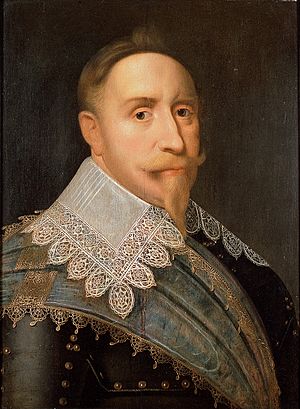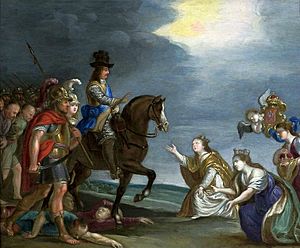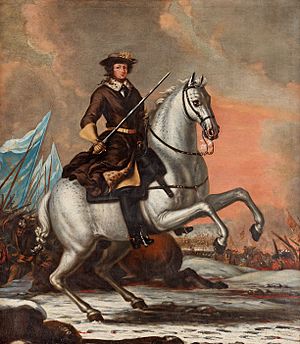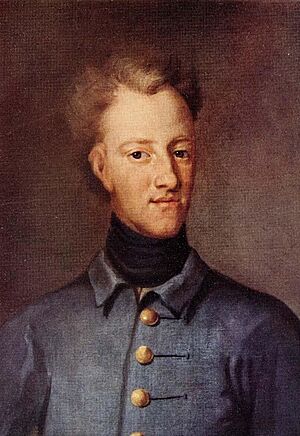Swedish Empire facts for kids
Quick facts for kids
Swedish Empire
Kingdom of Sweden Det svenska stormaktsväldet
Konungariket Sverige |
|||||||
|---|---|---|---|---|---|---|---|
| 1611–1718 | |||||||
|
Flag
|
|||||||
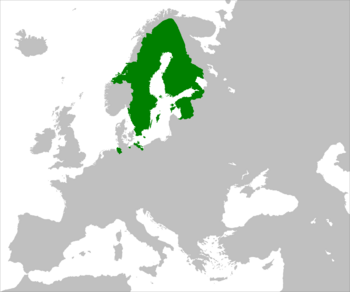
The Swedish Empire at its height in 1658. Overseas possessions are not shown.
|
|||||||
| Capital | Stockholm | ||||||
| Common languages | Swedish, Finnish, Norwegian, Estonian, Sami, German, Livonian, Latvian, Danish | ||||||
| Religion | Lutheranism (Eastern orthodox faith recognized as minority religion) |
||||||
| Government | Monarchy | ||||||
| King | |||||||
|
• 1611–1632
|
Gustav II Adolf the Great | ||||||
|
• 1632–1654
|
Christina | ||||||
|
• 1654–1660
|
Charles X Gustav | ||||||
| Lord High Chancellor | |||||||
|
• 1612–1654
|
Axel Oxenstierna | ||||||
|
• 1654–1656
|
Erik Oxenstierna | ||||||
|
• 1660–1686
|
Magnus Gabriel De la Gardie | ||||||
| Legislature | Riksdag of the Estates | ||||||
| Historical era | Early modern Europe | ||||||
|
• Established
|
1611 | ||||||
|
• Disestablished
|
1718 | ||||||
| Population | |||||||
|
• 17th century
|
2500000 | ||||||
| Currency | Riksdaler, Mark (until 1664), Carolin (from 1664) | ||||||
|
|||||||
| Today part of | |||||||
The Swedish Empire was a powerful country in Europe between 1611 and 1718. During this time, Sweden controlled a large area around the Baltic Sea. Historians call this period the "Swedish Empire" or "the era of great power."
Contents
What Was the Swedish Empire?
The Swedish Empire was a time when Sweden became one of the strongest countries in Europe. It grew from a smaller kingdom into a major military and political force. This happened through a series of wars and clever political moves.
How Sweden Became an Empire
Sweden's rise to power began in the early 17th century. It had a strong army and smart leaders. They wanted to control trade routes in the Baltic Sea. This sea was very important for shipping goods across northern Europe.
Key Goals of the Empire
The main goals of the Swedish Empire were:
- To control the Baltic Sea, making it a "Swedish lake."
- To gain more land and resources.
- To protect the Protestant faith in Europe.
Important Leaders of the Empire
Several kings and queens helped shape the Swedish Empire. They led armies and made important decisions.
Gustavus Adolphus: The Lion of the North
Gustavus Adolphus ruled from 1611 to 1632. He was a brilliant military leader. He made the Swedish army very modern and effective. His skills helped Sweden win many battles, especially during the Thirty Years' War. He is often called the "Lion of the North" for his bravery.
Queen Christina: A Time of Peace and Learning
Christina became queen in 1632 after her father, Gustavus Adolphus, died. She was very smart and loved learning. Her reign saw some peace and cultural growth. She later chose to give up her throne in 1654.
Charles X Gustav: Expanding the Empire
Charles X Gustav ruled from 1654 to 1660. He was a great warrior king like Gustavus Adolphus. He fought many wars, including against Poland and Denmark. He greatly expanded Sweden's territory. The empire reached its largest size during his time.
Charles XI: Building Up the Country
Charles XI ruled for a long time, from 1660 to 1697. He focused on making Sweden stronger from the inside. He improved the country's finances and military. He also worked to make the king's power stronger.
Charles XII: The Warrior King's Last Stand
Charles XII was the last king of the Swedish Empire. He ruled from 1697 to 1718. He was a very brave and skilled military leader. However, he fought in the Great Northern War against many enemies, including Russia. This war lasted a long time and was very costly for Sweden.
Life in the Swedish Empire
Life in the Swedish Empire was different for people depending on where they lived. Most people were farmers.
Religion and Languages
The main religion was Lutheranism. This was a form of Protestantism. While Swedish was the official language, many other languages were spoken. These included Finnish, German, Estonian, and Latvian. This was because the empire included many different lands and peoples.
The End of the Empire
The Swedish Empire began to decline after the Great Northern War (1700–1721). This war was fought against a group of countries, including Russia, Denmark, and Norway.
The Great Northern War
Charles XII led Sweden in this long and difficult war. Despite some early victories, Sweden eventually lost. The war drained Sweden's resources and weakened its army. After Charles XII died in 1718, the empire officially ended. Sweden lost most of its lands outside of modern-day Sweden and Finland.
Legacy of the Swedish Empire
Even though the empire ended, its history is still important. It shaped the borders and cultures of many countries around the Baltic Sea. It also showed how a smaller country could become a major power.
Images for kids
See also
 In Spanish: Imperio sueco para niños
In Spanish: Imperio sueco para niños



